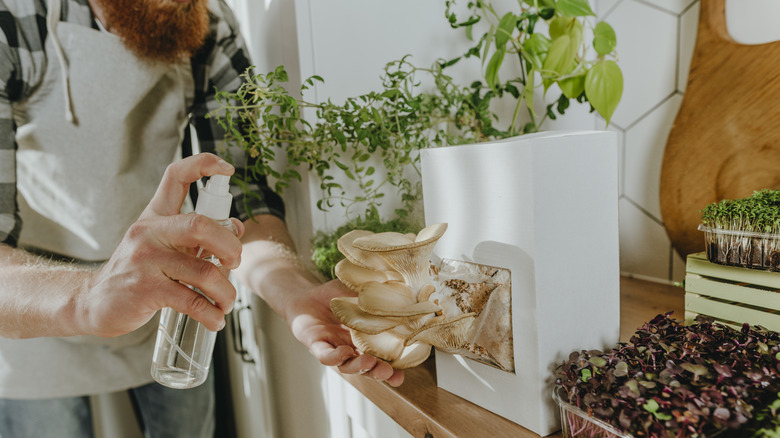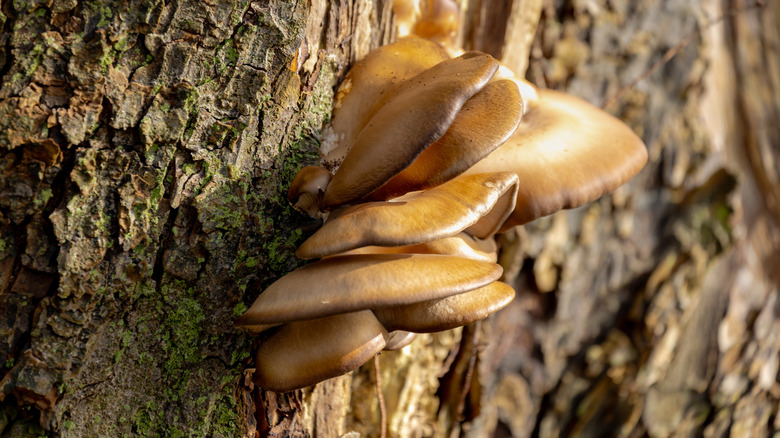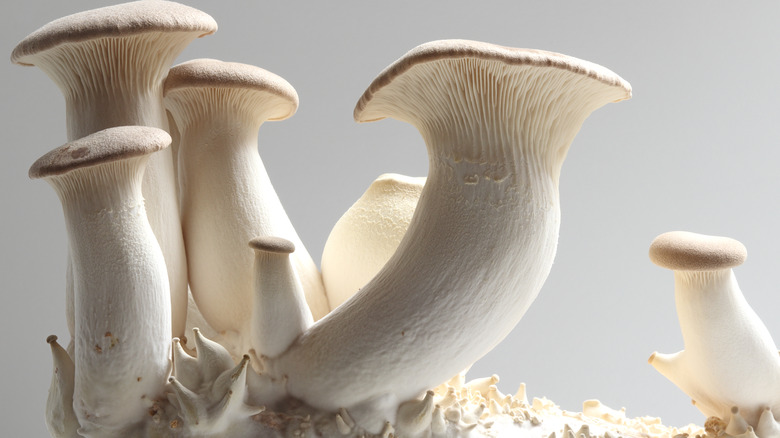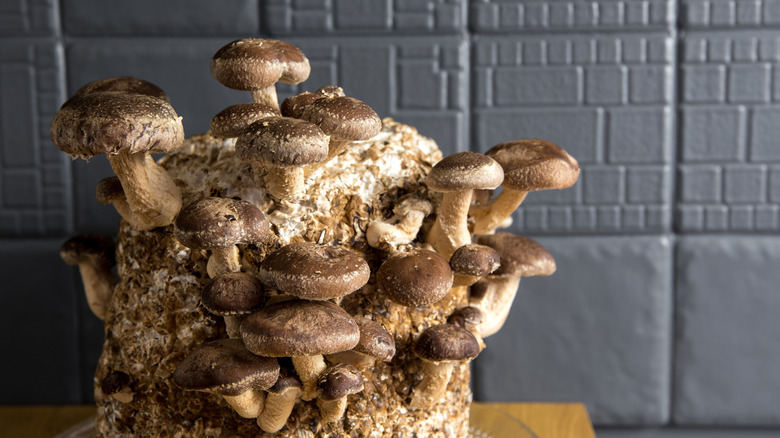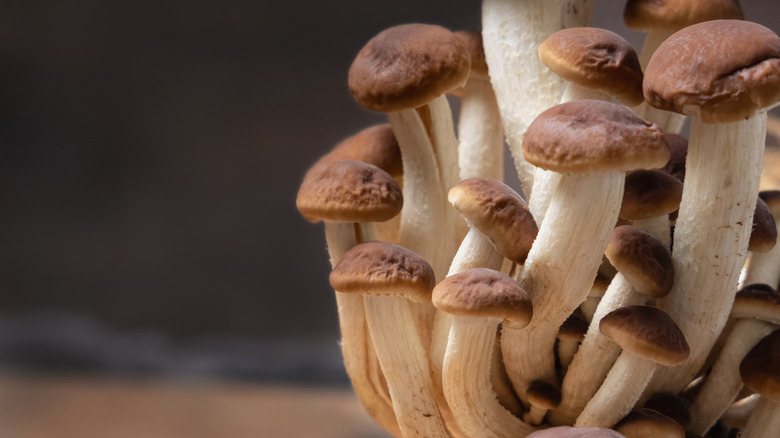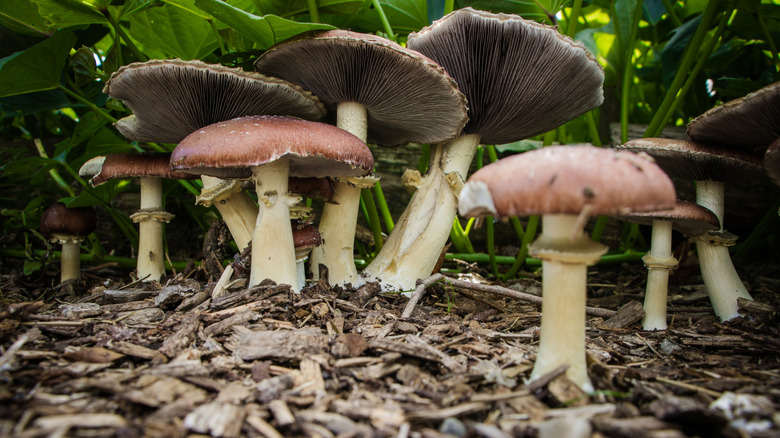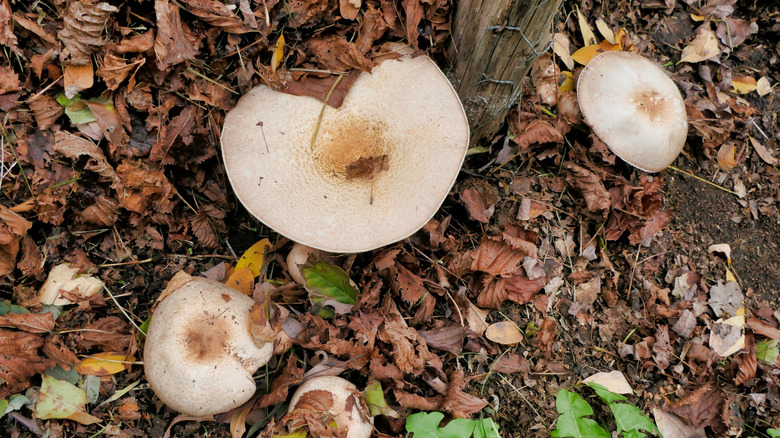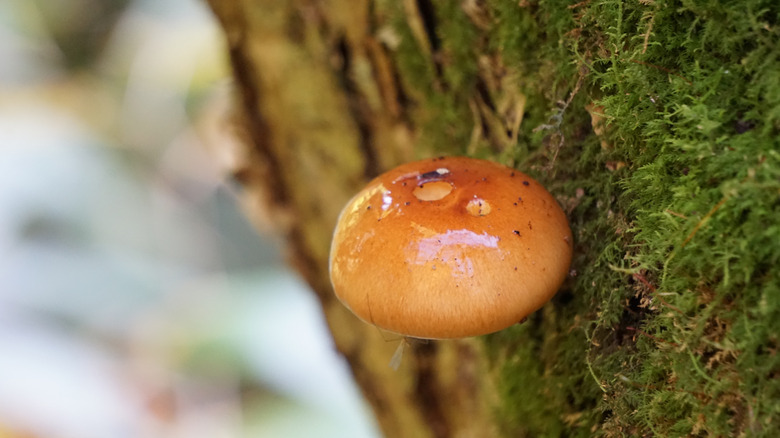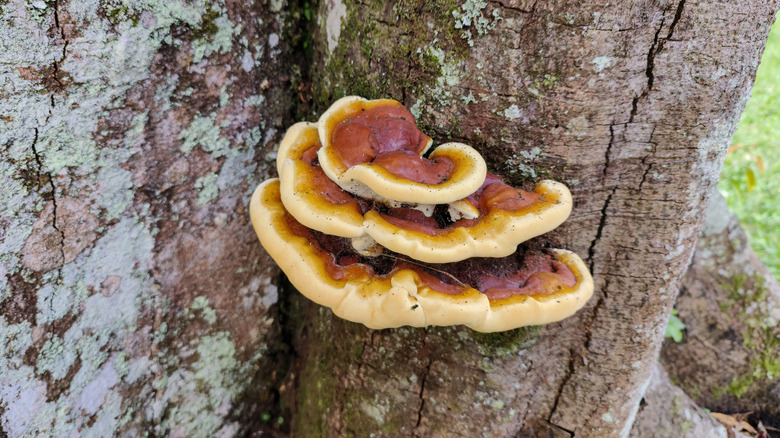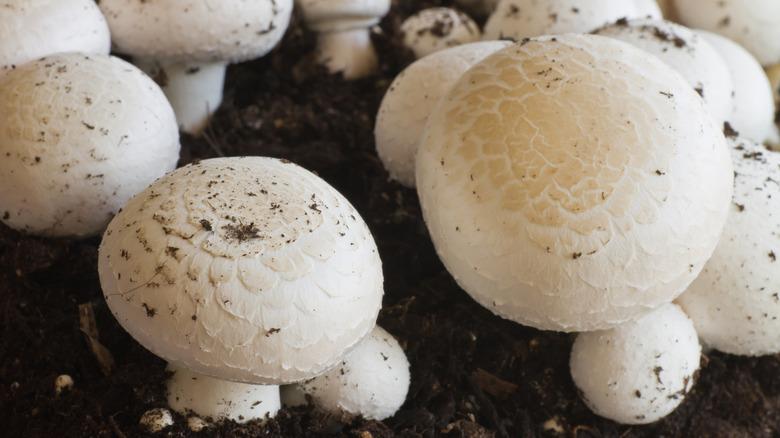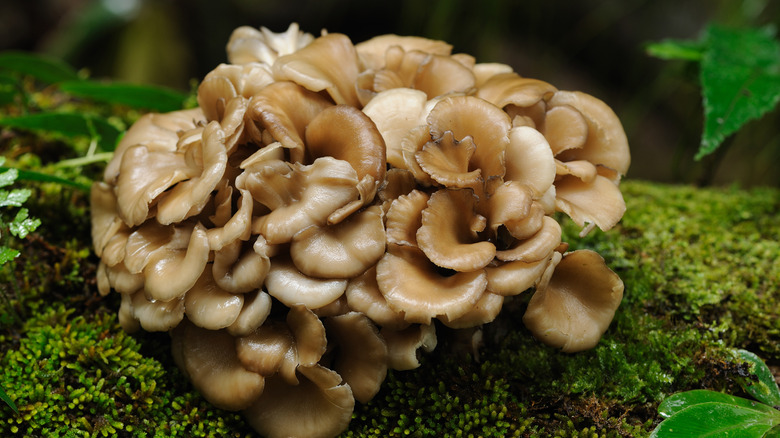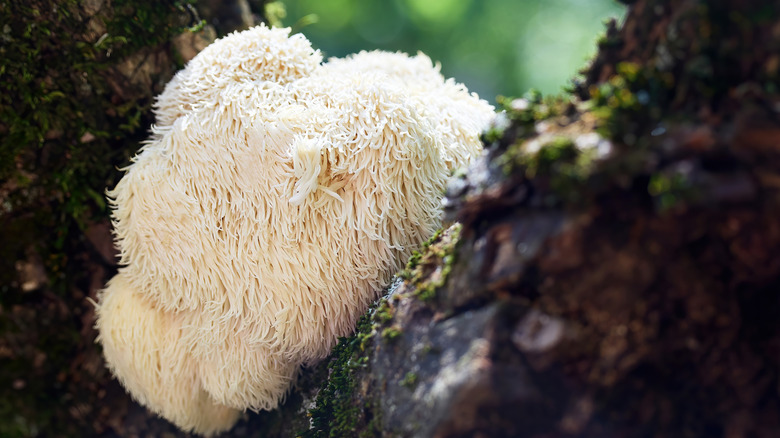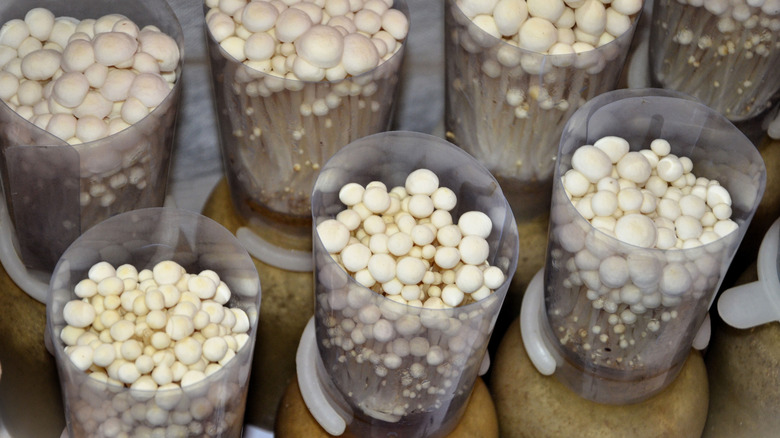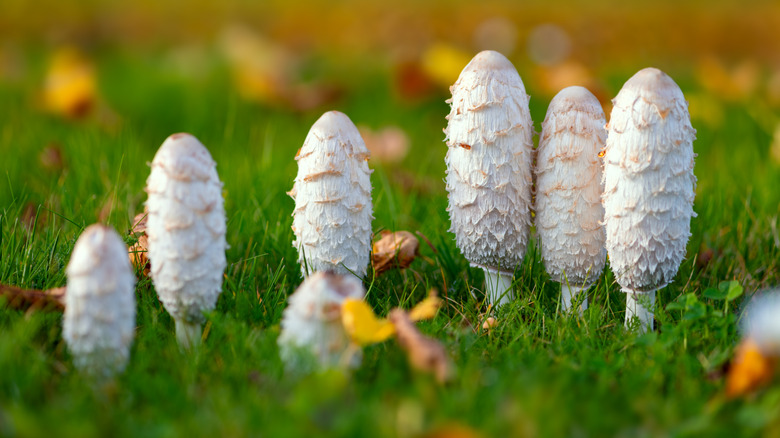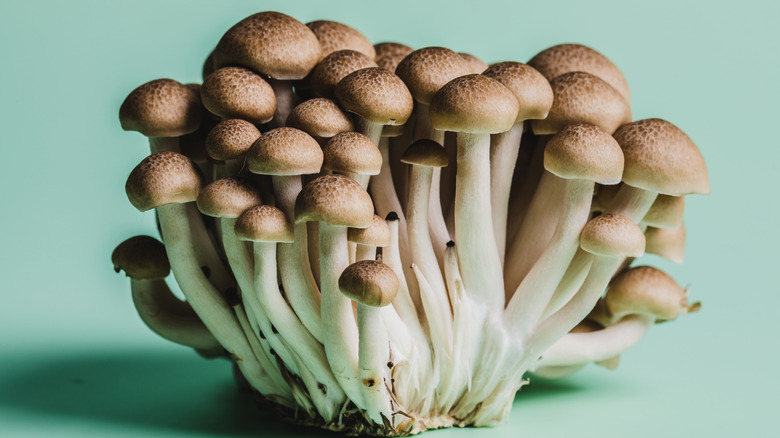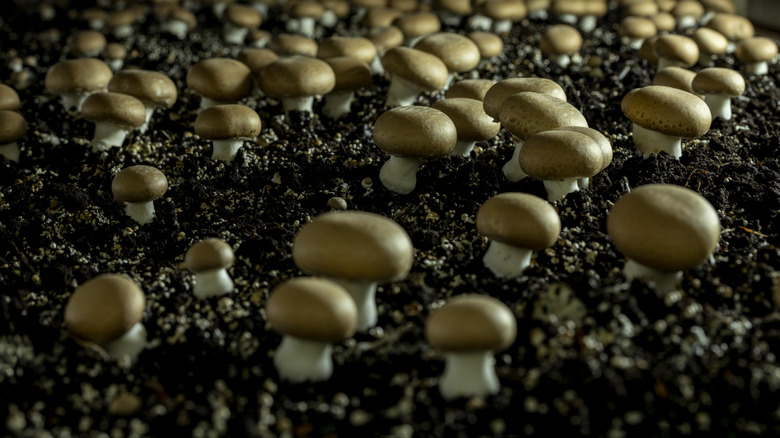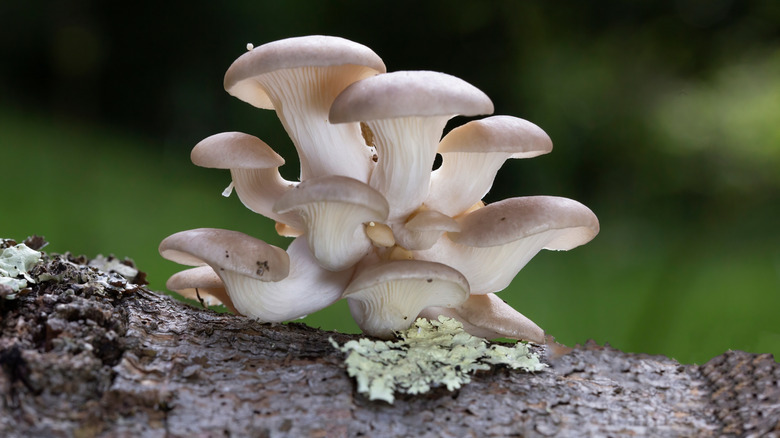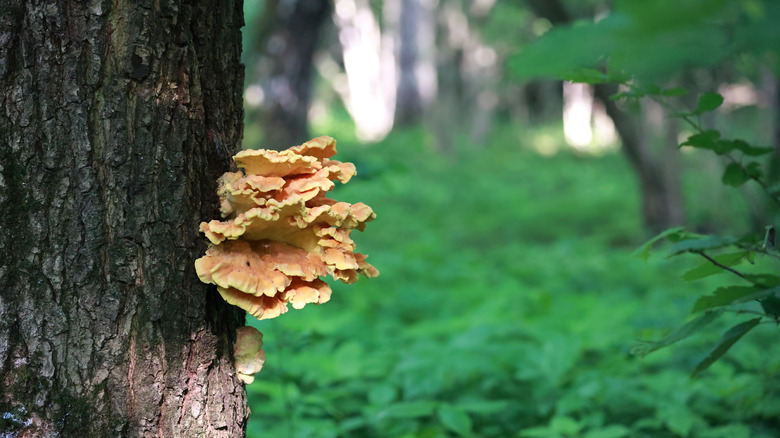17 Mushrooms You Should Be Growing At Home
Growing crops you can eat is incredibly rewarding. But, for many gardeners, mushrooms are not on their to-grow list. This is probably because growing mushrooms is a bit different from how you grow your usual veggies. Unlike plants, mushrooms do not need photosynthesis to grow. Instead, they rely on a substrate. They are a type of fungi and are more like animals than plants, digesting substances for nutrients instead of making their own food. However, mushrooms can be fairly easy to grow, with certain varieties such as the pearl oyster mushroom and the shiitake mushroom being perfect for beginners. If you are looking for a more intriguing mushroom to grow and are up to the challenge, you may want to go for maitake or chicken of the woods.
If you want to grow mushrooms at home and are new to the process, buying a cultivation kit is a great way to get into it. These kits come with everything you need to grow your own mushrooms, usually sold as bags of substrate and mushroom mycelium that you spray with water. However, a kit is not always necessary. All you need is mushroom spawn, a suitable substrate for the variety you are growing, and a whole load of patience!
Pearl oyster mushroom
Pearl oyster mushrooms (Pleurotus ostreatus) are a great choice for beginners, as these mushrooms can grow on loads of different substrates. You can grow them indoors on straw, cardboard, or sawdust blocks, or outside on logs. Pearl oyster mushrooms grow well in a dark room at temperatures of 75 to 77 degrees Fahrenheit. They like to be moist, and a humidity level of 80 to 90% is preferable. The fruit will start to appear after three weeks or so, and this process can be triggered by reducing the temperature and providing them with more light.
King oyster mushroom
King oyster mushroom (Pleurotus eryngii) is another easy grower that can be cultivated on a range of substrates, both indoors and outdoors. Like the pearl oyster variety, king oyster mushrooms should be started off in a dark room at temperatures of 75 to 77 degrees Fahrenheit with high humidity. You will need to keep them moist throughout the growing process. King oyster mushroom kits are pretty easy to get your hands on if you are going down that route. However, you can also purchase spawn that you can mix with sawdust, paper, straw, or cardboard.
Shiitake mushroom
Shiitake mushrooms (Lentinula edodes) are the second most produced mushroom variety in the world, and can be grown at home using sawdust, logs, or pellets as substrate. They do take a bit longer to get started than other varieties of mushrooms, but once they do, they can provide you with a huge harvest. Shiitake mushrooms should be grown in temperatures of 55 to 65 degrees Fahrenheit with a humidity of around 85%. They are a brilliant option for growing on logs, as an inoculated log can produce mushrooms for up to five years.
Velvet pioppino
Velvet pioppino (Agrocybe aegerita) can be grown on hardwood chips, sawdust, pellets, and logs. Although they may not be as easy to grow as other varieties of mushrooms, they are a fantastic addition to many dishes. Velvet pioppino needs a temperature of around 74 degrees Fahrenheit when starting off and a humidity of 90 to 95%. They will need light for fruiting and a slightly lower temperature of 59 to 68 degrees Fahrenheit. You can grow these mushrooms outdoors, either in a mushroom bed or on hardwood logs, which can be a nice addition to your garden.
King stropharia mushroom
The king stropharia mushroom (Stropharia rugosoannulata), also known as wine cap and garden giant, grows naturally on wood chips across North America. They are an excellent option for an outdoor mushroom crop and are easy to grow on wood chip substrate. They need a spot with partial shade and are perfect for growing around trees or perennials. You will need to pour an inch of substrate on the bed, sprinkle on the spawn, and then add two more inches of substrate on top. Keep them moist, and they will soon spread.
Almond agaricus mushroom
Almond agaricus (Agaricus subrufescens) is another fantastic mushroom species for growing outside in your garden. It is easy to grow in compost, so you can make use of your food scraps and garden waste! They prefer to grow in a shady area, and you will need to plant them out in the summer months, as frost can harm them when they first begin to grow. Almond agaricus mushrooms need to be kept moist, so you may want to place cardboard, straw, or shredded paper on top of the soil.
Nameko mushroom
Popular in Japanese dishes, nameko mushrooms (Pholiota microspora) can be grown at home either with cultivation kits or purchased spawn. You can grow this species on sawdust blocks or logs, and they tend to grow best in cooler temperatures of 40 to 55 degrees Fahrenheit. If you want to grow them outside, they do well on black cherry (Prunus serotina) and sugar maple (Acer saccharum) logs that have been cut within the last three months. It can be helpful to slightly bury the logs in wood chips to help retain moisture.
Reishi mushroom
Reishi mushrooms (Ganoderma sichuanense) have been used in China and other Asian countries for centuries because of their purported health benefits. Also known as lingzhi, reishi mushrooms can be cultivated on sawdust substrate and logs. The red variety, which is the more commonly grown type, is an interesting mushroom that can develop in long, finger-like forms. Cultivating reishi mushrooms on logs with sawdust spawn is a satisfying way of growing these, but you can also look at getting a fruiting block. However, they do tend to take longer to grow into mature mushrooms compared to other varieties.
Button mushroom
You are probably already familiar with button mushrooms (Agaricus bisporus). This species of mushroom is often sold in supermarkets, but you can grow your own at home to save on a trip to the store. Button mushrooms are best grown on compost beds consisting of manure and hay, and should be kept in the dark in a cool room. A humidity of 80 to 95 percent is suitable for button mushrooms, and it is helpful to mist the compost with water twice a day. Avoid pouring water on it, as this can disturb the growth of the mycelium.
Maitake mushrooms
With their beautiful frills and shapes, maitake mushrooms (Grifola frondosa) look as good as they taste! They usually grow near the base of oak trees in the wild and can be more difficult to cultivate at home. Also known as hen-of-the-woods, maitake mushrooms can be grown either with a sawdust substrate indoors or on a log outside. As maitake mushrooms love oak trees, inoculating an oak log for cultivation is preferable. The log does need to be kept moist, so ensure you are watering it if you notice it getting dry.
Lion's mane mushroom
Lion's mane mushroom (Hericium erinaceus) is a great choice for both indoor and outdoor growing and is relatively easy to cultivate. They can be grown with sawdust or wood pellets substrate indoors and on logs outside. If you are choosing to cultivate them indoors, your inoculated substrate should be placed in a dimly-lit location that is around room temperature. After two weeks, your lion's mane mushrooms will need a temperature of 60 to 70 degrees Fahrenheit and high humidity to fruit. During this time, they will need to be misted and kept moist.
Enoki mushroom
Enoki mushrooms (Flammulina filiformis) produce long, thin stems and small, white caps, and are a relatively simple mushroom to cultivate. You can easily grow these mushrooms in glass jars with a substrate of sawdust, cardboard, or paper. Enoki mushrooms need to be grown somewhere with a temperature of around 68 to 77 degrees Fahrenheit and a humidity of 85 to 95%. The mycelium will usually appear a few weeks after inoculation, and fruiting will occur not long after that. Enoki mushrooms grow pretty quickly, so make sure you harvest them as soon as you can!
Shaggy mane mushroom
Shaggy mane mushrooms (Coprinus comatus) are bell-shaped fungi covered in shaggy-looking scales. You may have seen them in parks, woodlands, and pastures during summer and fall, but you can grow them at home, too. Nutrient-rich compost that has a manure base is the best substrate for shaggy mane mushrooms. It is essential to keep the substrate moist and the humidity high throughout the growing process. A humidity of 80 to 90% provides your shaggy mane mushrooms with the perfect conditions for growing and fruiting. Once harvested, you will need to use the mushrooms as soon as possible.
Beech mushroom
Native to East Asia, beech mushrooms (Hypsizygus tessulatus) produce small, thin fruits that are popular in cooking. As their name suggests, these mushrooms tend to grow on trees, particularly the beech tree. This means that they can do well when grown on logs. However, you can also use sawdust or straw as a substrate. Your beech mushroom spawn will need 70 to 75 degrees Fahrenheit during incubation, and it will take the spawn up to 90 days to be ready for fruiting. Once it is, lower the temperature to 55 to 65 degrees Fahrenheit.
Portobello mushroom
Portobello mushrooms (Agaricus bisporus) are actually the fully mature version of the button mushroom. They are the same species, but just at different points of their growth cycle, and therefore taste different when harvested. This means that, like button mushrooms, they need to be grown in compost in a dark, cool room. You will see them grow into button mushrooms, but to get to a portobello version, you will need to hold off on harvesting them. Portobello mushrooms are at maturity when their caps have turned brown and are 4 to 6 inches in diameter.
Phoenix oyster mushroom
The phoenix oyster mushroom (Pleurotus pulmonarius) is fairly similar to the pearl oyster mushroom, but it is smaller and paler. It also needs warmer temperatures to grow, so it may be a better choice for you depending on where you live. You can grow this variety either outdoors on logs or inside on sawdust blocks. Once your substrate is inoculated with the phoenix oyster mushroom spawn, it will need to be kept at 75 to 84 degrees Fahrenheit. Spray your substrate twice a day to keep it moist.
Chicken of the woods mushroom
Chicken of the woods (Laetiporus sulphureus) is a frilled, golden-yellow fungus. It is a common mushroom that grows on trees, and this means that it does well when grown outdoors on logs. However, you can also grow it inside on sawdust blocks. If you choose to grow it outside, use a hardwood log like oak and place it somewhere fairly shady. It can take chicken of the woods up to a year to fruit, but an inoculated log will produce mushrooms you can harvest for a good few years.
